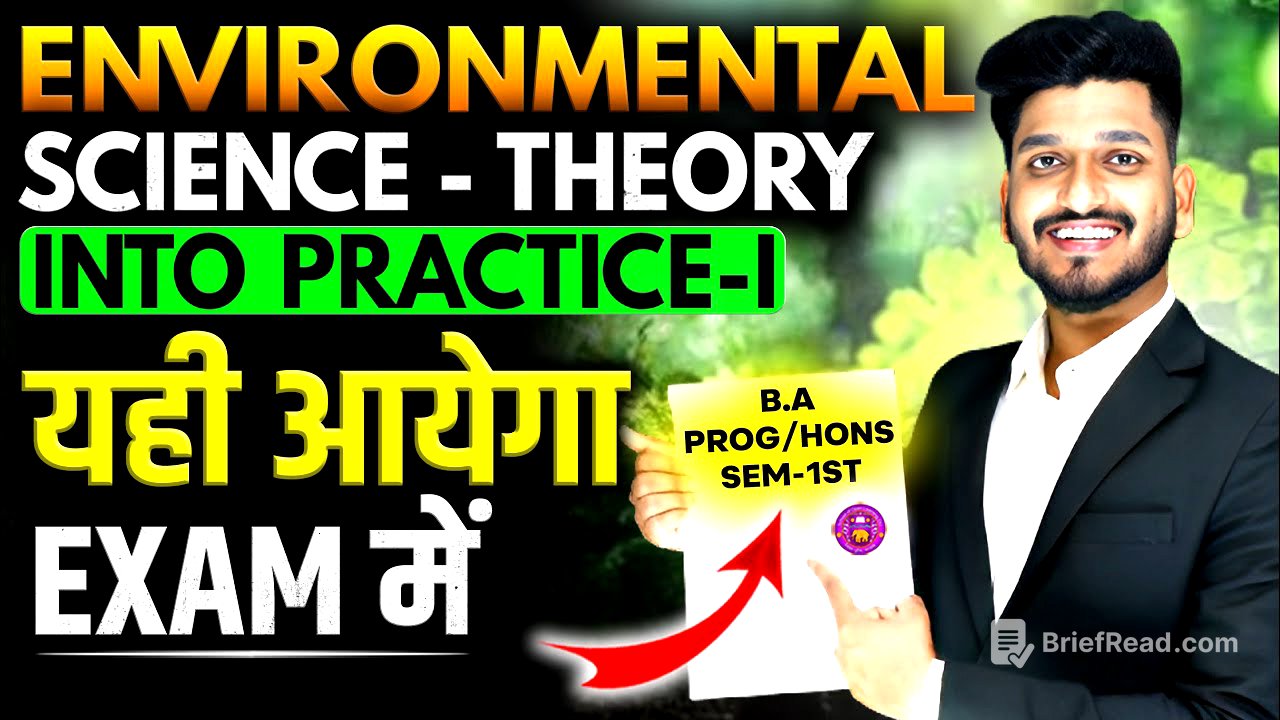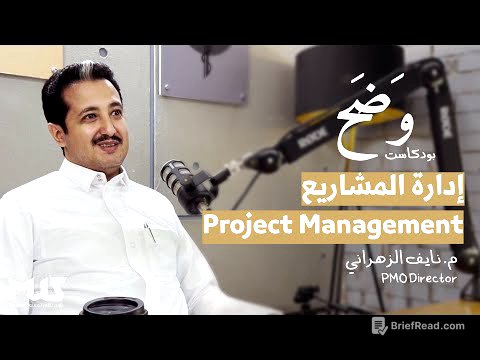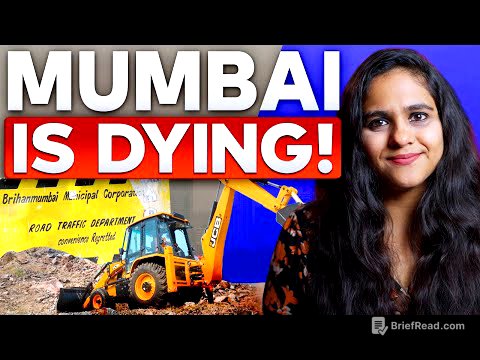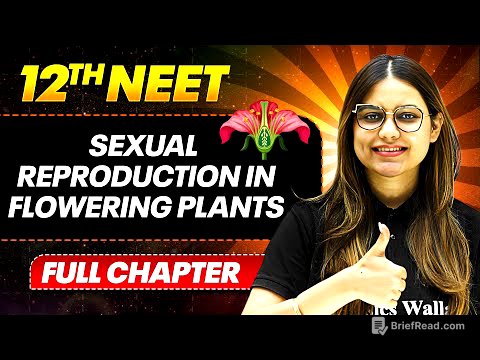TLDR;
This video by Manish Verma provides a comprehensive overview of an Environmental Science syllabus, covering key concepts, definitions, and important topics. It includes detailed explanations of each chapter, sample questions, and discussions on various environmental issues. The video aims to help students understand the syllabus and prepare for exams effectively.
- Syllabus overview with 10 chapters
- Definitions and explanations of key environmental terms
- Discussion on sustainable development goals and environmental issues
- Case studies and examples to illustrate concepts
Introduction to Environmental Science [0:25]
The video begins with an introduction to the Environmental Science syllabus for an Honours BA program. The syllabus includes 10 chapters categorized into four units. The presenter emphasizes the importance of understanding the syllabus to answer exam questions effectively. The first chapter introduces environmental studies, focusing on the environment and its impact on us.
Ecosystem Concepts and Structure [2:12]
Chapter two covers the concept of ecosystems, their structure, pyramids, and sequencing. It explains how organisms depend on each other for food and how energy transformation occurs within the ecosystem. The chapter also touches on biochemical cycles and productivity studies.
Ecosystem Types, Natural Resources, and Pollution [3:04]
Chapter four discusses the types and services provided by ecosystems. Chapter five introduces natural resources, including land and water resources. Chapter six and seven focus on wind as an energy resource and its benefits. Chapter eight introduces pollution, covering various types and their pollutants.
Pollution Types and Waste Management [4:12]
The video continues with Chapter 8, discussing air, noise, and nuclear pollution. Chapter 9 covers water, thermal, and soil pollution. Chapter 10 focuses on solid waste management, including methods for waste decomposition and elimination.
Sample Questions: Hydrosphere, Land Degradation, Soil Erosion [4:47]
The presenter starts answering sample questions to illustrate the type of questions that may appear in exams. The first question defines the hydrosphere as an area surrounded by water, covering approximately 70% of the Earth's surface, including oceans, lakes, and rivers. Land degradation is explained as the loss of land fertility due to over-exploitation, leading to soil erosion and potential floods. Soil erosion is defined as the removal of the upper layer of soil by wind or water, causing a loss of good soil particles.
Primary Productivity, Geothermal Energy, Lithosphere [9:05]
Primary productivity is explained as the initial cooking of food by plants through photosynthesis, converting sunlight into starch. Geothermal energy is defined as heat energy produced from the Earth, used to rotate turbines and generate electricity. The lithosphere is described as the uppermost layer of the Earth's surface, containing mountains, plates, and minerals.
Hazardous Waste, Water Storage, and True/False Statements [13:25]
Hazardous waste is defined as waste material that can harm human, animal health, and the environment, including chemicals and gases. Water storage is discussed in the context of agriculture, with dams being used to store water for irrigation. The video then transitions to true/false statements related to sustainable development goals, plastic use, e-waste, and environmental movements.
True/False: Apiko Movement, Desert Ecosystems, Renewable Energy [18:15]
The presenter continues with true/false statements, correcting the misconception that the Apiko Movement started in Uttar Pradesh, clarifying it began in Canada. Deserts are identified as not highly productive ecosystems due to water scarcity. Renewable energy resources are discussed, distinguishing them from traditional energy resources.
True/False: PM10 Particles, Water Productivity, and Short Notes Introduction [20:23]
The discussion on true/false statements continues with PM10 particles, explaining their higher diameter and impact on lung health. Water is described as essential for plant growth, and mangrove forests are identified as productive ecosystems. The video then transitions to short notes, starting with an explanation of the tundra.
Short Notes: Tundra, River Water Conflict, and Yamuna Cleaning [22:45]
The tundra is defined as a high-altitude, treeless area with low temperatures and snow. River water conflict is discussed, highlighting disputes between countries over water resources. The cleaning of the Yamuna River is mentioned, with subsidies from the Netherlands and Japan, and the Namami Gange project launched in 2015.
Short Notes: Mining Impact, Deforestation, and Water Conservation [31:54]
The harmful impacts of mining on the environment are explained, including soil erosion, air and water pollution, and the release of greenhouse gases. Anthropogenic causes of deforestation are discussed, emphasizing the need for tree plantation. Steps for water conservation in metropolitan cities are outlined, including efficient irrigation systems and rainwater harvesting.
Water Conservation in Cities and Challenges [44:59]
The video details water conservation methods in domestic, business, and public sectors. Challenges in water conservation are discussed, including systematic urbanization and increasing population demands. The importance of water harvesting and sustainable development is emphasized.
River Pollution in India and Government Initiatives [50:41]
The presenter discusses the high pollution levels in Indian rivers despite government initiatives and legislation. Industrial waste, domestic sewage, and religious rituals are identified as major causes. Government initiatives like the Water Act and Ganga Action Plan are mentioned.
Sustainable Manufacturing and Automotive Industry [1:01:53]
Sustainable manufacturing is defined as creating products through economically sound processes that minimize environmental impact. The video focuses on the automotive industry, suggesting sustainable measures for two-wheeler manufacturing, including water and energy consumption reduction.
Sustainable Development Goals (SDGs) and Implementation [1:13:05]
The video discusses three Sustainable Development Goals (SDGs) and the steps countries can take to achieve them by 2030. It highlights the importance of ending hunger, promoting clean water and sanitation, and improving the quality of life through sustainable development.
SDG 2: Zero Hunger and SDG 6: Clean Water and Sanitation [1:17:55]
The presenter elaborates on SDG 2 (Zero Hunger), discussing initiatives like the Midday Meal Scheme and ration systems. For SDG 6 (Clean Water and Sanitation), the video emphasizes the need for safe and affordable drinking water and effective waste water treatment.
Coal Consumption and Environmental Impact [1:27:55]
The video analyzes coal consumption patterns and their socio-economic and environmental impacts. It discusses the government's plan to reduce coal usage to almost zero by 2050 and suggests renewable energy sources like wind and solar energy as alternatives.
Renewable Energy Sources and Pollution Reduction [1:36:32]
The benefits of renewable energy sources such as wind, solar, and water energy are highlighted for reducing pollution and greenhouse gas emissions. Additional steps for pollution reduction include tree plantation, wildlife conservation, and promoting public transport.
Ecosystems and Food Chains [1:41:13]
The video explains the importance of ecosystems, using a grass ecosystem as an example. It discusses the biotic and abiotic features of ecosystems, food chains, and the transfer of energy between organisms.
Ecological Pyramids and Ecosystem Structure [1:48:11]
The concept of ecological pyramids is introduced, along with the 10% law of energy transfer. The structure of ecosystems is explained, including biotic and abiotic components, productivity, and the roles of producers, consumers, and decomposers.
Natural Resource Conservation and Conflicts [1:56:53]
The video discusses the conservation of natural resources and the conflicts that arise from their use. It focuses on land, water, and energy resources, highlighting the impacts of mining and pollution.
Conflict Resolution and Resource Management [1:59:50]
Strategies for resolving conflicts related to natural resources are presented, including tree plantation, forest management, and waste management. The importance of water harvesting, pollution prevention, and the use of renewable energy sources is emphasized.
Mountain Ecosystems and Cultural Aspects [2:04:59]
The video concludes with a discussion on mountain ecosystems, highlighting the unique culture, lifestyle, and food of mountainous regions. It emphasizes the importance of maintaining harmony with the environment and promoting sustainable tourism.









